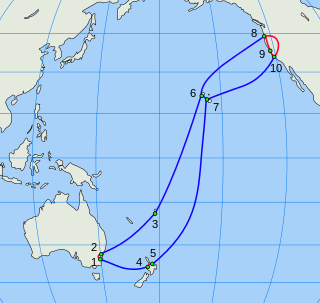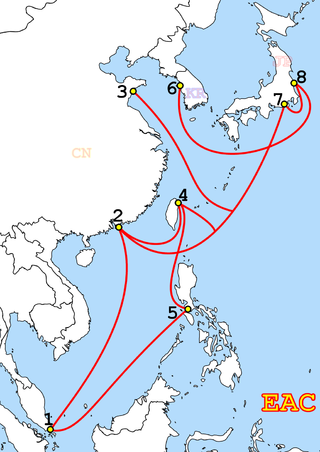
The Southern Cross Cable is a trans-Pacific network of telecommunications cables commissioned in 2000. The network is operated by the Bermuda-registered company Southern Cross Cables Limited. The network has 28,900 km (18,000 mi) of submarine and 1,600 km (990 mi) of terrestrial fiber optic cables, all which operate in a triple-ring configuration. Initially, each cable had a bandwidth capacity of 120 gigabit/s. Southern Cross offers capacity services from 100M/STM-1 to 100 Gbit/s OTU-4, including 1G, 10G and 40G Ethernet Private Line services.
The Eastern Africa Submarine Cable System (EASSy) is an undersea fibre optic cable system connecting countries in Eastern Africa to the rest of the world.

South East Asia–Middle East–Western Europe 4 is an optical fibre submarine communications cable system that carries telecommunications between Singapore, Malaysia, Thailand, Bangladesh, India, Sri Lanka, Pakistan, United Arab Emirates, Saudi Arabia, Egypt, Italy, Tunisia, Algeria and France. It is intended to be a complement to, rather than a replacement for, the SEA-ME-WE 3 cable.
APCN 2 or Asia-Pacific Cable Network 2 is a submarine telecommunications cable linking several countries in the Asia-Pacific region.

EAC-C2C is a submarine telecommunications cable system interconnecting several countries in Asia, the Pacific, and the United States. It is a merger of the former EAC and C2C cable systems. The merger occurred in 2007 by Asia Netcom, and the cable system is now owned/operated by Pacnet. Pacnet was acquired by the Australian telecommunications company Telstra in 2015.
Reach North Asia Loop (RNAL) is a multi-terabit intra-Asia self-healing submarine telecommunications cable system, connecting the principal cities in Asia.
Unity is a Trans-Pacific submarine communications cable between Japan and the United States that was completed in April 2010.

SEACOM launched Africa's first broadband submarine cable system along the continent's Southern coasts in 2009. SEACOM is privately owned and operated.

Pacnet was a global telecommunications service provider between 2008 and 2015. It was formed from the operational merger of Asia Netcom and Pacific Internet on 8 January 2008. It was owned by a private investor group comprising Ashmore Investment Management Limited, Spinnaker Capital Limited and Clearwater Capital Partners. Its acquisition by the Australian telecommunications company Telstra was announced at the end of 2014, and completed in April 2015.
Europe India Gateway (EIG) is a submarine communications cable system that connects the U.K., Portugal, Gibraltar, Monaco, France, Libya, Egypt, Saudi Arabia, Djibouti, Oman, United Arab Emirates, and India.

The West Africa Cable System (WACS) is a submarine communications cable linking South Africa with the United Kingdom along the west coast of Africa that was constructed by Alcatel-Lucent. The cable consists of four fibre pairs and is 14,530 km in length, linking from Yzerfontein in the Western Cape of South Africa to London in the United Kingdom. It has 14 landing points, 12 along the western coast of Africa and 2 in Europe completed on land by a cable termination station in London. The total cost for the cable system is $650 million. WACS was originally known as the Africa West Coast Cable (AWCC) and was planned to branch to South America but this was dropped and the system eventually became the West African Cable System.
Asia Pacific Gateway (APG) is a submarine communications cable system that connects Mainland China, Hong Kong, Japan, South Korea, Malaysia, Taiwan, Thailand, Vietnam and Singapore. It will be about 10,400 kilometres (6,500 mi) long. The capacity will be 54.8 terabits per second. The APG cable consortium includes Facebook, CAT Telecom, China Telecom, China Mobile International, China Unicom, Chunghwa Telecom, KT Corporation, LG Uplus, NTT Communications, StarHub, Global Transit, Viettel and VNPT. The APG cable system was scheduled to be ready for service in 2016.
TSE-1 or Taiwan Strait Express 1 is the first submarine telecommunications cable directly linking Taiwan island and mainland China. At 270km in length, the cable offers the shortest route between Taiwan and mainland China while avoiding seismically active zones prone to disruption during earthquakes. TSE-1 was completed on January 18, 2013. Once activated, traffic between Taiwan and China will no longer have to be routed via the Asia-Euro Under-sea Optical Cable, the China-US Cable Network or the Asia Pacific Cable Network 2.
West Indian Ocean Cable Company (WIOCC) operates as a wholesaler, providing capacity to international telecoms, cloud operators, content providers and internet service providers within and out of Africa. WIOCC offers carriers connectivity to over 550 locations across 30 African countries – utilising more than 75,000 km (47,000 mi) of terrestrial fibre and 200,000 km (120,000 mi) of submarine fibre-optic cable. WIOCC's international network reach currently extends to 100 cities in 29 countries in Europe and more than 700 cities in 70 countries globally.

The South Atlantic Inter Link (SAIL) is a submarine communications cable in the South Atlantic Ocean linking Kribi, Cameroon with Fortaleza, Brazil.

MAREA is a 6,605 km long transatlantic communications cable connecting the United States with Spain. Owned and funded by Microsoft and Meta Platforms, but constructed and operated by Telxius, a subsidiary of the Spanish telecom company Telefónica, it is the "highest-capacity submarine cable in the world" with a system design capacity of 200 terabits per second as of 2019.
Dunant is a private 250 Tbit/s 6,600 kilometre transatlantic communications cable that connects the United States with France (Saint-Hilaire-de-Riez). Named for Henry Dunant, it was announced by Google in 2018 and went live in 2020.
South East Asia–Middle East–Western Europe 6 is an in-progress optical fibre submarine communications cable system that would carry telecommunications between Southeast Asia, the Middle East, and Western Europe. Construction began in early 2022. It is expected to be operational in the first quarter of 2025 The expected cable length is 19,200 km and it has a design capacity of 126 Tbit/s, using SDM technology.
The Oman Australia Cable (OAC) is a 9,800 km fibre-optic submarine communications cable that entered service in September 2022, linking Oman and Australia via the Cocos (Keeling) Islands. The cable consists of three fibre pairs and had an initial design capacity of 39 terabits per second.








